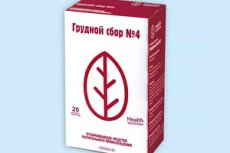該文的醫學專家
新出版物
乳房系列之四
阿列克谢·克里文科,医学审稿人
最近審查:04.07.2025
最近審查:04.07.2025

4号乳房收集品含有沼泽野生迷迭香的嫩枝、金盏花的花、薄荷的叶、洋甘菊的花、甘草的根和野三色堇的草,是一种草药收集品,经常用于民间医学和植物疗法,以治疗各种疾病和改善身体状况。
该系列具有多种特性,可用于缓解各种疾病的症状,包括呼吸道、胃肠道、神经系统等疾病。系列中列出的每种成分都有其独特的特性,可对身体产生有益作用。
例如:
- 金盏花具有抗炎和防腐的功效。
- 洋甘菊花具有镇静和抗炎的功效。
- 薄荷叶可能有助于缓解咳嗽和鼻塞等呼吸系统疾病的症状。
- 裸甘草根具有包裹和抗炎作用,可以帮助缓解喉咙和胃粘膜的刺激。
混合物的成分和比例可能因具体配方和治疗目标而异。使用丰胸系列4号前,建议咨询医生或草药师,以确定合适的剂量和使用方式,并考虑可能的禁忌症和个体体质特征。
適應症 乳房收集 #4。
呼吸系统疾病:
- 咳嗽,尤其是伴有咳痰的咳嗽。
- 鼻塞,流鼻涕。
- 喉咙和呼吸道发炎。
胃肠道疾病:
- 消化不良、胃灼热。
- 胃和肠粘膜发炎。
- 绞痛和肠道蠕动减弱。
神经紊乱:
- 压力、神经兴奋、失眠。
其他条件:
- 皮肤炎症、痤疮。
- 免疫力下降,感冒。
- 女性经期疼痛。
發布表單
丰胸系列4号是草本系列,含有以下成分:
- 沼泽野生迷迭香芽(Menyanthes trifoliata):沼泽野生迷迭香在民间医学中被广泛用作抗炎和止血剂。
- 金盏花:金盏花具有抗炎和防腐特性,还能增强免疫系统并促进伤口愈合。
- 薄荷叶(Mentha x piperita):薄荷具有舒缓的功效,可以帮助缓解喉咙刺激并缓解呼吸困难。
- 洋甘菊花(Matricaria chamomilla):洋甘菊具有抗炎和镇静作用,可以帮助缓解咳嗽并减少呼吸道炎症。
- 甘草根(Glycyrrhiza glabra):甘草具有抗炎特性,有助于舒缓喉咙和呼吸道的刺激。
- 野三色堇(Viola tricolor):三色堇具有温和的利尿和抗炎作用,有助于减轻肿胀和炎症。
藥效學
- 沼泽野生迷迭香芽:具有抗炎和抗菌功效。野生迷迭香有助于缓解呼吸道炎症,促进排痰。
- 金盏花:具有抗炎和防腐特性,促进组织愈合并减少喉咙刺激。
- 薄荷叶:含有薄荷醇精油,具有清凉和抗炎特性,有助于舒缓刺激和缓解呼吸。
- 洋甘菊花:具有抗炎和镇静功效。洋甘菊有助于放松支气管肌肉,减少咳嗽,促进睡眠。
- 甘草根:具有抗炎和粘液溶解特性。甘草有助于舒缓呼吸道刺激并减少炎症。
- 野三色堇草:具有软化和抗炎作用,有助于软化粘膜并促进排痰。
藥代動力學
- 沼泽拉布拉多茶:可能与抗凝剂、抗血小板剂和一些心脏药物发生相互作用。
- 金盏花:相互作用通常有限,但可能与抗凝剂和镇静剂发生相互作用。
- 薄荷:可能会干扰某些药物的吸收,尤其是同时服用时。
- 洋甘菊:可能增强镇静剂和抗凝剂的效果。
- 甘草:与多种药物相互作用,包括糖皮质激素和地高辛。
- 野三色堇:可能与抗凝剂和心血管药物相互作用。
劑量和管理
输液的准备:
- 为了准备输液,每杯开水(约 200 毫升)可以使用 1-2 茶匙 4 号草药。
- 将草药混合物放入碗中,加入沸水,然后盖上锅盖,浸泡 15-20 分钟。
接待:
- 草药茶可以温热服用,每日2-3次,每次半杯(约100毫升)。如有需要,可根据医生建议增加或减少剂量。
治疗时长:
- 疗程长短取决于病情和身体对药物的反应。通常建议服用草药7-14天。
笔记:
- 遵循医生关于剂量和使用期限的建议非常重要。
- 在使用任何药物(包括草药)之前,您应该咨询医生,特别是如果您有任何慢性疾病或正在服用药物。
在懷孕期間使用 乳房收集 #4。
沼泽野生迷迭香的嫩芽:
- 沼泽野生迷迭香含有毒性物质,可能引起严重的副作用,例如心律失常,甚至中毒。怀孕期间使用野生迷迭香是极其不明智的,因为它会对母亲和胎儿的健康产生负面影响。
金盏花:
- 金盏花一般被认为是安全的,但外用时则需谨慎。怀孕期间内服金盏花可能会增加流产的风险,因为它可能会影响月经周期,并可能对子宫产生刺激作用。
薄荷叶:
- 适量食用薄荷通常是安全的,但可能会影响消化系统并引起胃灼热或反流,这些情况在怀孕期间往往会恶化。
洋甘菊花:
- 孕期少量使用洋甘菊被认为相对安全。然而,使用洋甘菊可能会导致子宫肌张力下降,这具有潜在危险,尤其是在妊娠晚期。
裸甘草根:
- 甘草可能会导致体液潴留、血压升高和低钾血症,因此在怀孕期间使用具有潜在危险。
野三色堇:
- 野三色堇一般被认为是安全的,但关于其在怀孕期间的安全性和有效性的具体数据有限。
禁忌
沼泽野生迷迭香的嫩芽:
- 有些人可能对沼泽野生迷迭香有过敏反应。因此,含有该成分的制剂应谨慎使用。
金盏花:
- 金盏花可能会引起某些人的过敏反应,尤其是对菊科植物过敏的人。
- 不建议孕妇和哺乳期妇女在未咨询医生的情况下使用含有金盏花的制剂,因为这些情况下的安全性尚未确定。
薄荷叶:
- 对于某些人来说,薄荷可能会引起过敏反应或加重胃灼热症状。
- 未经医生许可,不建议幼儿、孕妇或哺乳期妇女使用薄荷产品。
洋甘菊花:
- 洋甘菊可能会引起某些人的过敏反应。
- 不建议孕妇或哺乳期妇女在未咨询医生的情况下使用洋甘菊产品,因为这些情况下的安全性尚未确定。
裸甘草根:
- 甘草根可能会升高血压并导致体液潴留,因此高血压患者应限制使用。
- 由于甘草产品可能对胎儿或婴儿产生不利影响,因此不建议孕妇或哺乳期妇女在未咨询医生的情况下使用甘草产品。
野三色堇:
- 野三色堇可能会引起某些人的过敏反应。
- 不建议孕妇和哺乳期妇女在未咨询医生的情况下使用含有野三色堇的制剂。
副作用 乳房收集 #4。
- 过敏反应:该混合物中的某些成分,例如金盏花或洋甘菊花,可能会引起某些人过敏反应。过敏症状可能表现为皮疹、瘙痒、发红或肿胀。
- 胃肠道疾病:由于混合物中含有甘草根,可能会出现胃灼热、恶心、呕吐、腹泻或血压升高等胃肠道疾病。
- 嗜睡或疲劳:混合物中的某些成分,例如洋甘菊花或薄荷叶,可能会导致某些人感到嗜睡或疲劳,尤其是大量食用时。
過量
- 中枢神经系统症状:镇静作用增强可能导致严重嗜睡、昏睡、头晕,甚至失去意识。
- 胃肠道疾病:过量服用可能引起恶心、呕吐、腹泻等胃肠道疾病,从而导致脱水和电解质紊乱。
- 过敏反应:对该系列中的一种或多种成分过敏的人可能会出现过敏反应,如皮疹、瘙痒、血管性水肿或过敏性休克。
- 呼吸系统疾病:在某些情况下,过量服用可能会导致呼吸抑制,甚至呼吸停止。
- 心脏和循环问题:混合物中的某些成分可能会影响心脏功能和循环,从而导致心律失常或血压升高。
與其他藥物的相互作用
- 沼泽拉布拉多茶:可能与抗凝剂、抗血小板剂和一些心脏药物发生相互作用。
- 金盏花:相互作用通常有限,但可能与抗凝剂和镇静剂发生相互作用。
- 薄荷:可能会干扰某些药物的吸收,尤其是同时服用时。
- 洋甘菊:可能增强镇静剂和抗凝剂的效果。
- 甘草:与多种药物相互作用,包括糖皮质激素和地高辛。
- 野三色堇:可能与抗凝剂和心血管药物相互作用。
注意!
為了簡化對信息的理解,本指令使用了藥物 "乳房系列之四",並根據藥物的醫療用途官方說明。 使用前請閱讀直接用於藥物的註釋。
描述僅供參考,不適用於自我修復指導。 這種藥物的需求,治療方案的目的,藥物的方法和劑量僅由主治醫師確定。 自我藥療對你的健康有危害。


